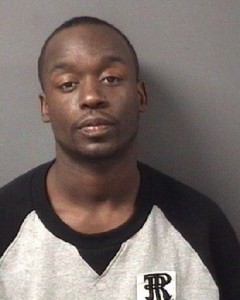Crime scene detective goes over finer details in Batie murder retrial
A crime scene detective testified Tuesday about some of the finer details of an investigation that led to the arrest of two city men who are suspected of killing off-duty Mercer County corrections officer Carl Batie.
Marcellos Rosa Delgado, a crime scene technician with Trenton Police, described combing the murder scene for evidence outside of Baldassari Regency banquet hall in the early-morning hours of Nov. 11, 2012.
She was called out to the scene shortly before 2 a.m., after chaos engulfed the banquet hall when a gunman opened fire on the packed balcony, striking Batie in the head. He was pronounced dead at the hospital.
Maurice Skillman and Hykeem Tucker are on trial a second time, charged with murder in Batie’s slaying. Skillman was the alleged gunman, while Tucker acted as a lookout, prosecutors said.
Their first trial this year ended in a mistrial as a jury could not reach a unanimous verdict.
By the time Rosa Delgado arrived, the murder scene was roped off with yellow crime scene tape and secured by police officers who stood watch outside
She meticulously collected and photographed evidence from the scene. She collected 22 spent shell casings in the parking lot of the banquet hall, along with two bullet fragments.
Rosa Delgado processed some of the cars in the parking lot for DNA and fingerprints. She said she lifted seven fingerprints off a blue Impala, but only two were “suitable” for comparison of others kept in a fingerprint database used by law enforcement.
The fingerprints turned out to be a dead end, Rosa Delgado said. No hits came back connecting anybody to the fingerprints at the scene.
Rosa Delgado also took pictures of vents outside of the banquet hall deck that had “strike marks,” from where some of the bullets ricocheted. Jurors were shown photos of the vents, bearing a pair of apparent bullet marks.
She collected a New York Giants Snapback hat, a black winter hat, a dark ski mask and a black bandanna from streets surrounding the banquet hall. DNA tests were run on some of the items.
Jurors were informed at the first trial that DNA belonging to an individual named Edward Acosta was present on the Giants’ hat. Acosta was, for all intents and purposes, a mystery man at the first trial.
He was never connected to or charged with Batie’s murder, and all authorities could say about the individual is he was on a city street near the banquet hall where a murder took place, and he left his hat.
Prosecutors said they don’t plan to have a forensic scientist testify about the DNA link to Acosta at the second trial.
They believe the DNA evidence, which was offered to show police conducted a thorough investigation, may have confused the last panel, leading it question the judge about whether it could consider alternative theories.
Prosecutors tried to eliminate prospective jurors with a yearning for arm-chair detective work from the second trial by asking them whether they had watched the popular Netflix docuseries “Making a Murderer,” which chronicled the life of convicted killer Steven Avery, of Wisconsin.
Prosecutors believe the influence of the show has made their job more difficult, similar to the so-called CSI effect, discussing the impact the crime-scene detective show has had on jurors in criminal trials.
Some legal experts say the phenomenon is largely anecdotal and point to studies that discount its effect on jurors.
One legal expert told The Trentonian that the question about “Making a Murderer” appeared to target specific jurors who may be more skeptical of law enforcement and the criminal justice system.
Prospective jurors in other parts of New Jersey have not been asked about the show during jury selection.
The trial resumed this afternoon.









